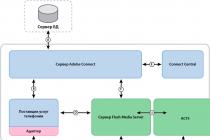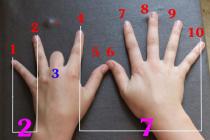Today we are going to talk about iPhone - Apple smartphones. It is difficult enough to imagine that at least someone would not hear about this brand, which has gained immense popularity all over the world. There are several lines of iPhones on the smartphone market from Apple, and now we will see how they differ from each other.
Differences between iPhone 4 and iPhone 4s
At first glance, you may not notice the external differences between the iPhone 4S and iPhone 4. Indeed, both devices are very similar, they have identical dimensions - 115.2 x 58.6 x 9.3 mm, and the bodies are made of metal and glass. But there is one minor difference: the iPhone 4S has the volume buttons a few millimeters lower than the iPhone 4.
Technical specifications
- The single-core A4 processor (ARM Cortex A8) in the iPhone 4 has been replaced by the dual-core A5 (ARM Cortex A9) in the newer model. Due to this, of course, the iPhone 4S has become even more powerful and productive.
- Expanded the amount of memory. In the iPhone 4, either 8 GB or 32 GB was available to users. And the iPhone 4S has 8GB, 16GB, 32GB, and 64GB storage.
- Lovers take photos on their phones and instantly send them to social networks should rejoice, since the iPhone 4S has an 8MP camera, as opposed to the 5MP camera in the iPhone 4. It is now possible to record videos in FullHD quality, as well as a face recognition function for video recording and LED backlighting. In addition, stabilization has improved, and the photo quality has become much higher.
- iPhone 4S supports CDMA networks, and the data transfer rate in HSDPA increased to 14.4 Mbps, while the iPhone 4 did not exceed 7.2 Mbps.
- The Bluetooth module in the iPhone 4S has become 4.0, and in the iPhone 4 only 2.1 + EDR.
- Software has not undergone significant changes. But the Siri application appeared in the iPhone 4S, with its help the smartphone can open applications, perform various actions, due to voice commands... By the way, thanks to him, the letter S appeared in the fourth iPhone.
Differences between iPhone 5 and iPhone 5s
So, let's decide that we will only compare the iPhone 5S and iPhone 5. We will deliberately not distinguish between the iPhone 5C as well, since this model differs from the iPhone 5 almost only appearance- the manufacturers have replaced the classic metal case with a very high-quality plastic. By the way, the iPhone 5C is available in the following colors: white, blue, yellow, green and pink. Another difference is that the built-in memory of the iPhone 5C does not have a 64 GB option, which is rather inconvenient and is a disadvantage for modern users.
But we will return to the latest model of the fifth iPhones. iPhone 5S has a number of certain differences from its predecessors, which will now be discussed.
- First of all, we note that technical innovations appear in the iPhone 5S: Touch ID - a fingerprint scanner that is built into the Home key. Also iPhone 5S has the latest processor- Apple A7. Thanks to this innovation, the performance of the iPhone 5S is doubled compared to the iPhones on the A6 processor.
- The improved camera on the iPhone 5S is worth noting. The quality of photos has become better, super-fast video recording - 120 frames per second and a double flash have been added. Let's dwell on the flash. She has an LED lamp, which is equipped with two colors, due to this, objects in twilight and darkness in photographs look more natural.
- As for the external differences between the IPhone 5S and the iPhone 5, it is that the first one is made in new designs: Silver, Gold, New space gray, i.e. iPhone 5S is available in gray, gold, and black.
- The iPhone 5S differs from the iPhone 5 in that it supports the most modern standards mobile communications, namely 13 LTE frequencies.
iPhone 6 and iPhone 6 Plus
Now let's talk about latest models iPhones, which made a lot of noise. So, we present to your attention the iPhone 6 and iPhone 6 Plus. Manufacturers decided to improve smartphones and introduced interesting innovations:
- The iPhone 6 Plus has a 5.5-inch screen size, while the iPhone 6 has a 4.7-inch screen size.
- The iPhone 6 Plus has a screen resolution of 1920 x 1080 pixels per inch, while the iPhone 6 is slightly smaller at 1334 x 750 pixels per inch.
- Both smartphones - iPhone 6 and iPhone 6 Plus are equipped with an 8MP iSight camera with f / 2.2 aperture, which has face recognition and is endowed with a five-element lens.
- The only difference between the cameras of these models is that the first one has optical stabilization Images.
If you cannot decide what kind of iPhone you want to buy, we advise you to refer to the articles.
Actually, for an experienced user or geek interested in technological innovations, this question is irrelevant. At the same time, people far from the IT world sometimes wonder - how can you accurately determine the model of a device just by looking at it?
In contact with
So, how do you know which iPhone you found, noticed in the hand of the interlocutor or saw in the picture in the ad? Below we will deal with the visual distinctive features of Apple smartphones of a particular model, starting with the flagship ones.
How to visually identify each iPhone model?

- Year of issue: 2018
- Diagonal: 5.8 inch
- Model number: A1920, A2097, A2098 (for Japan) and A2100 (for China)
- Drive capacity: 64 GB, 256 GB, 512 GB
- Colors:
- SIM card type: nano-SIM,

- Year of issue: 2018
- Diagonal: 6.5 inch
- Model number: A1921, A2101, A2102 (for Japan) and A2104 (for China)
- Glass case (front and back) with medical steel frame
- The "ON" button is located on the right side of the device
- There is a black rectangle at the top of the display that houses the True Depth sensors
- Home button and Touch ID sensor missing
- Drive capacity: 64 GB, 256 GB, 512 GB
- Colors: gold: silver, space gray
- Dual vertically oriented main camera on the back
- SIM card type: nano-SIM,
- IMEI is listed on the SIM card tray
- 3.5mm audio jack is missing
The main external differences between the flagships of 2018 () from the iPhone X are: the gold color and the larger size of the iPhone XS Max.

- Year of issue: 2018
- Diagonal: 6.1 inch
- Model number: A1984, A2105, A2106 (for Japan) and A2107 (for China)
- Glass body (front and back) with anodized aluminum frame
- The "ON" button is located on the right side of the device
- There is a black rectangle at the top of the display that houses the True Depth sensors
- Home button and Touch ID sensor missing
- Drive capacity: 64, 128, 256 GB
- Colors: black, blue, white, coral, yellow, (PRODUCT) RED
- SIM card type: nano-SIM,
- IMEI is listed on the SIM card tray
- 3.5mm audio jack is missing
The front of the iPhone XR looks like a slightly larger iPhone X or iPhone XS, while the sides and back are like the iPhone 8.

iPhone 6s and iPhone 6s Plus

iPhone 6s Plus

- Year of issue: 2015
- Diagonal: 5.5 inch
- A1634, A1687, A1699
- The "ON" button is located on the right side of the device
- Drive capacity: 16 GB, 64 GB, 128 GB
- Colors:
- SIM card type: nano-SIM
- IMEI is listed on the SIM card tray
- Year of issue: 2015
- Diagonal: 4.7 inch
- Model number on the back: A1633, A1688, A1700
- The "ON" button is located on the right side of the device
- Touch ID built into the Home button
- Drive capacity: 32 GB, 128 GB, 256 GB
- Colors:, "pink gold"
- Distinguishing mark "S" on the rear panel
- SIM card type: nano-SIM
- IMEI is listed on the SIM card tray
- 3.5mm audio jack present
iPhone 6 and iPhone 6 Plus

- Year of issue: 2014
- Diagonal: 5.5 inch
- Model number on the back: A1522, A1524, A1593
- The "ON" button is located on the right side of the device
- Touch ID built into the Home button
- Drive capacity: 16 GB, 64 GB, 128 GB
- Colors: Space gray, silver, gold
- SIM card type: nano-SIM
- 3.5mm audio jack present
- Year of issue: 2014
- Diagonal: 4.7 inch
- Model number on the back: A1549, A1586, A1589
- The "ON" button is located on the right side of the device
- Touch ID built into the Home button
- Drive capacity: 16 GB, 64 GB, 128 GB
- Colors: Space gray, silver, gold
- SIM card type: nano-SIM
- IMEI is listed on the back of the device
- 3.5mm audio jack present
How the iPhone 6s and iPhone 6s Plus look different from the iPhone 6 and iPhone 6 Plus
The iPhone 6s and iPhone 6 (as well as the iPhone 6s Plus with the iPhone 6 Plus) are visually almost identical - both devices are wrapped in a body that has remained largely unchanged since 2014, when Apple designers decided to increase the display diagonal from 4 to 4.7 inches.
The main external differences are: the distinctive "S" mark on the back, pink and 3D Touch display on the iPhone 6s and iPhone 6s Plus, as well as the absence of an engraved IMEI numbers... In addition, if you have an incredibly accurate eye or sense of weight, you may notice that the "simple sixes" are a little lighter and thinner.

- Year of issue: 2016
- Diagonal: 4.7 inch
- Model number on the back: A1723, A1662, A1724
- Touch ID built into the Home button
- Oval shaped flash
- Drive capacity: 16 GB, 32 GB, 64 GB, 128 GB
- Colors: Space gray, silver, gold, rose gold
- Distinguishing mark "SE" on the rear panel
- SIM card type: nano-SIM
- IMEI is listed on the back of the device
- 3.5mm audio jack present
How the iPhone SE outwardly differs from the iPhone 5 and iPhone 5s
In 2016, Apple introduced the iPhone SE smartphone, which combines the design of the 4-inch iPhone 5s and the inside of the iPhone 6s. Outwardly, distinguishing the iPhone SE from the iPhone 5s is quite difficult. The main visual differences are: the distinctive 'SE' badge on the back, matte bevels on the edges of the iPhone SE (they seem sharper on the iPhone 5s), and the model in the case in Rose Gold color. All of the aforementioned features are present only on the iPhone SE.
The iPhone 5 design is described below.
You can learn more about all the differences between the iPhone SE and other iPhone models from our following materials:

- Year of issue: 2013
- Diagonal: 4.7 inch
- Model number on the back: A1453, A1457, A1518, A1528,
A1530, A1533 - The "ON" button is located on the upper end of the device
- Touch ID built into the Home button
- Oval shaped flash
- Drive capacity: 16 GB, 32 GB, 64 GB
- Colors: Space gray, silver, gold
- SIM card type: nano-SIM
- IMEI is listed on the back of the device
- 3.5mm audio jack present
To begin with, there are three versions of the tenth iPhone - A1902, A1865 and A1901. Of these, only the latter is officially sold in the Russian Federation; it is also supplied to most European countries, the Middle East, and Canada. You can find the model number on the box, inside the SIM card slot, or in the device information section of the settings operating system iOS. But what to be prepared for when purchasing an American or Chinese gadget with an index of 1865 or A1902, intended for Japan?
What are the differences between A1865, A1901 and A1902?
4G LTE frequencies. Several years ago, the operation of an iPhone from America was complicated by the inconsistency of the frequencies of LTE networks and, as a result, the inability to fully use mobile internet on US devices. However, in the case of the latest "apple" smartphones, the nuance has already lost its relevance: if you carefully study the specifications of the "dozen", it turns out that the supported ranges for the A1865 and A1902 models are exactly the same as for the A 1901 variant. Thus, the Zaoken smartphone will work with SIM-cards of Russian cellular operators just like the "sim cards" of companies from the United States. The only difference is that the US modification, in addition to GSM networks, also supports the CDMA standard, and the "Japanese" is compatible with additional bands FDD-LTE Band 11 (1500 MHz) and 21 (1500 MHz), as well as TD-LTE 42 (TD 3500). However, their presence or absence does not play a role in Russian conditions.
Charger. When you buy an iPhone-X Model 1865 for sale in the US or China, take care of the power supply adapter. Their sockets differ in the shape of the pins, which means that it is easy to charge the "state" or Chinese iPhone it won't work in Russia. Fortunately, the cost of the adapter is not high, they are sold at a hardware store. In addition, many retailers pre-pack them with the appropriate adapters.
Apple Pay. By purchasing an iPhone X A1865 from the United States or A1901 from Europe, the owner will be able to use the contactless payment function from Apple. The fact is that American and European iPhones for this purpose use NFC technology, which is used in payment terminals of domestic stores. But if you got a Japanese device, then you can forget about the convenience of one-touch payments - in the Land of the Rising Sun, a different standard is adopted, called FeliCa.
FaceTime. When buying an iPhone X from Saudi Arabia or the United Arab Emirates, please note that FaceTime video calling service is blocked on your smartphone. Only jailbreak will help to activate the service. What is said in this paragraph applies only to smartphones officially designed for sale in these regions. If you buy an "apple" imported from Europe in the UAE, then there will be no difficulties.
Internet speed. One of the key differences between the iPhone X in different countries lies in the installed 4G modem. The A1865 comes with a Qualcomm chip, while the A1901 comes with an Intel chip. It is generally accepted that Intel solutions are inferior in performance to Qualcomm products. The difference in operating speed can reach 30%, and with a weak signal, the lag reaches 75%. At the same time, Russian LTE frequencies are supported by both modems, so the problem lies only in the performance of chips from two suppliers.
Shutter sound. All iPhones for sale in Japan and a number of other Asian markets have made the camera shutter sound non-muted. This is an intentional measure so that the owner of the phone with one of the best mobile cameras could not conduct hidden photography. You can disable protection only through jailbreak.
Guarantee. The ability to repair the phone free of charge in the event of a breakdown through no fault of the user is one of the main reasons why buyers are afraid to order the top ten from abroad. And it is not unreasonable: the manufacturer gives a factory warranty only for the A1901 model. iPhone A1865 and A1902 will also be repaired, but only at the expense of the owner of the "tube".
As a matter of fact, these are all the key differences between the versions of the iPhone X for different parts of the world. And how to distinguish a fake from a genuine Cupertin's "dozen", read our with live examples in the photo.
Why is it more profitable to buy an iPhone in the Mobiat.ru online store?
Ordering a smartphone at some foreign trading platform seems attractive only at first glance. However, the price of the purchase must be added to the price of the delivery service from abroad and the long wait. Sometimes even a parcel from China, neighboring Russia, has to wait a month.
Buying a smartphone on the site, the client will receive the goods on the same day and at a price lower than on the Apple site. It will be delivered to your home or office within Moscow and the Moscow region, and payment is made only after a thorough check in the presence of a courier. All iPhones purchased from us have a one-year warranty, during which we will repair the gadget free of charge in case the breakdown is not the user's fault. The Mobiat online store only sells original Apple smartphones, not copies.
Fair, not overpriced or understated. There should be prices on the Service website. Necessarily! without "asterisks", it is clear and detailed, where it is technically possible - the most accurate, final.
With the availability of spare parts, up to 85% of complex repairs can be completed in 1-2 days. Modular repairs take much less time. The website lists the approximate duration of any repairs.
Warranty and liability
Any repairs must be guaranteed. Everything is described on the website and in the documents. The guarantee is self-confidence and respect for you. A 3-6 month warranty is good and sufficient. It is needed to check quality and hidden defects that cannot be detected immediately. You see honest and realistic terms (not 3 years), you can be sure that they will help you.
Half of the success in Apple repair is the quality and reliability of spare parts, so a good service works with suppliers directly, there are always several reliable channels and your own warehouse with proven spare parts of current models so that you do not have to waste extra time.
Free diagnostics
This is very important and has already become a good form for service center... Diagnostics is the most difficult and important part of the repair, but you shouldn't pay a dime for it, even if you don't repair the device as a result.
Repair in service and delivery
A good service appreciates your time, therefore it offers free shipping... And for the same reason, repairs are carried out only in the workshop of the service center: correctly and according to technology, it can only be done at a prepared place.
Convenient schedule
If the Service works for you, and not for itself, then it is always open! absolutely. The schedule should be convenient so that you can be in time before and after work. Good service works both on weekends and on holidays. We are waiting for you and working on your devices every day: 9:00 - 21:00
The reputation of professionals consists of several points
Age and experience of the company
Reliable and experienced service has been known for a long time.
If a company has been on the market for many years, and it has managed to establish itself as an expert, people turn to it, write about it, recommend it. We know what we are talking about, since 98% of incoming devices in the SC are being restored.
We are trusted and transferred by other service centers for difficult cases.
How many masters in directions
If several engineers are always waiting for you for each type of equipment, you can be sure:
1. there will be no queue (or it will be minimal) - your device will be taken over immediately.
2. You are handing over your Macbook to a Mac repair expert. He knows all the secrets of these devices
Technical literacy
If you ask a question, a specialist must answer it as accurately as possible.
So that you have an idea of what exactly you need.
They will try to solve the problem. In most cases, the description tells you what happened and how to fix the problem.
Generations and varieties of iPhone
Since the summer of 2007, when the first generation of iPhones was released, models and varieties Apple smartphone a lot has accumulated:
- iPhone 2G (aluminum)
- iPhone 3GS in two flavors - with old and new bootrom
- iPhone 4 in three flavors - regular model, CDMA model and 2012 model
- iPhone 5 in two flavors - the American model and the "global model"
- iPhone 6 and iPhone 6 Plus
- iPhone 6s and iPhone 6s Plus
- iPhone 7 and iPhone 7 Plus
- iPhone XS and iPhone XS Max

The very first, aluminum iPhone, unlike other generations. A characteristic difference is a large black plastic insert for antennas in the lower part of the rear wall of the case. Although the name is stuck to this generation, it does not mean the generation of the iPhone itself, but the generation cellular networks in which he works. The first iPhone only supported second generation networks (including GPRS and EDGE).

Has a completely plastic body in white or black. All inscriptions on the rear wall are in gray paint. The iPhone was named so because it supported 3G cellular networks.

Externally, it almost completely repeats the look of the iPhone 3G, the only difference is that the inscriptions on the back wall are applied in exactly the same silver mirror paint as the Apple logo.
Old and new iPhone 3GS bootroms
From the point of view of prospects, jailbreak is of two types - with the old bootrom and with the new bootrom. Butrom(bootrom) is a non-rewritable hardware device bootloader, and the prospects for jailbreak largely depend on the presence of vulnerabilities in it. The difference between the old and the new bootrom continues to this day: for iPhone 3GS with old bootrom guaranteed untethered jailbreak for any iOS version, and for iPhone 3GS with a new bootrom- only tethered (read about the difference between tethered and untethered jailbreak).
It is easy to distinguish an iPhone 3GS with a new bootrom by its serial number. It is necessary to take the third, fourth and fifth digits. The third digit encrypts the year of production (9 = 2009, 0 = 2010, 1 = 2011), the fourth and fifth are the ordinal number of the week of the year in which the iPhone was released (from 01 to 52). The first iPhone 3GS with a new bootrom began to appear in the 40th week of 2009, and from the 45th week the new bootrom began to be used in all iPhones released. Thus, if the third digit of the iPhone 3GS serial number is 0 or 1, it definitely has a new bootrom. If the third digit is 9, look at the fourth and fifth digits. If they are less than or equal to 39, the bootram is exactly old; if they are greater than or equal to 45, the bootram is exactly new.
To know serial number iPhone 3GS is possible without turning on the device. the serial is printed on the SIM card tray. However, this is not a very reliable method, especially when buying. the tray is easy to replace. You can find out the exact serial number either in iTunes (at home page device properties), or on the device itself, in the "Settings-General-About this device-Serial number" menu.

It differs significantly from all previous iPhones, firstly, in design, and secondly in display. Both the front and back panels are made entirely of glass, and the smartphone is surrounded by a metal rim-antenna around the perimeter.
There are three iPhone models 4:
- common GSM model that looks exactly like the photo above
- CDMA Model iPhone 4 it is distinguished by the absence of a SIM tray and a different antenna design - there is no black stripe on it to the right of the headphone jack.
- second revision of iPhone 4, which began release in 2012, looks no different from the regular iPhone 4 GSM, but its processor has much fewer jailbreak vulnerabilities. You can only distinguish this iPhone model using third-party utilities, for example, redsn0w. Connect your gadget to your computer, download redsn0w for OS X or Windows, run the utility. Go to the Extras-Even more-Identify menu, in the window that opens, scroll down the text and look at the value in the ProductType line. If there "iPhone3,1" is a regular GSM-iPhone 4, if "iPhone3,2" is a new revision of iPhone 4 GSM; and the CDMA model is designated "iPhone3,3".


Looks pretty much the same as the iPhone 4 GSM, but the antenna design is the same as the iPhone 4 CDMA, and the iPhone 4S always comes with a SIM tray.
However, the most reliable way to tell the difference between an iPhone 4S is the model code on the back. If the second line below the word iPhone says "Model A1387", you are definitely looking at the iPhone 4S.

It differs from all other generations of iPhone in height - with the same screen width, its diagonal has grown to 4 inches. Back iPhone panel 5 is made of aluminum, and glass inserts covering the antennas are placed above and below.
Initially, the iPhone 5 was released in two flavors - "model for America" and "global model". The difference between them lies in the list of supported LTE bands, but for Russia this is practically irrelevant, since none of these models can work on the Russian frequencies allocated for 4G.
You can distinguish between iPhone 5 models by the model code on the back. "Model A1428" gives "American model" and model A1429 "global".

The first iPhone released in a multi-colored plastic case. Available in blue, green, pink, yellow and white.
iPhone 5c came in 6 hardware models - A1532 (for North America and China), A1456 (CDMA model for US and Japan), A1507 (for worldwide model), A1529 (for Southeast Asia), A1516 and A1526 (for China) which differ in the composition of the supported LTE bands.

The first iPhone with a Touch ID scanner. The fingerprint scanner is built into the Home button, which has lost the icon, but has received a metal rim. The other external differences between the iPhone 5s and the iPhone 5 are the dual flash and reduced clearance around the Power button and volume buttons.
iPhone 5s came in 6 hardware models - A1533 (for North America and China), A1453 (CDMA model for North America and Japan), A1457 (global model), A1518 and A1528 (for China), and A1530 (for Southeast Asia) ), which differ in the composition of the supported LTE bands.

An unusual version of the iPhone, as the name suggests. It has no numbers, and the letters SE stand for Special Edition. Externally, the smartphone differs little from the iPhone 5s, but its hardware filling corresponds to the iPhone 6s. As for performance, here the reduced iPhone is even in the lead, outstripping the top ones. Apple flagships 2015 year. External differences there is practically no between the iPhone 5s and SE: SE is available in rose gold, while the 5s is not; in addition, on the back of the iPhone SE there is an additional marking - a square with rounded corners and the inscription "SE" inside.
iPhone SE is released in 3 hardware models - A1662 (for America), A1724 (for China) and A1723 (for the rest of the world). It is important to note that the American model A1662 does not support the popular LTE-band 7 in Russia.
In 2017, the iPhone SE line was redesigned, replacing the 16 and 64 GB models with 32 and 128 GB models.

It was marked not only by a change in design, but also by another increase in the screen diagonal. Externally, the iPhone 6 is similar to the very first generation of the iPhone - a lot of metal, rounded corners. But that's where the similarities end: the iPhone 6 is much thinner, different in the shape and position of the buttons. So, Power button moved from the top to the right side of the smartphone. Another characteristic (and not the most pleasant) iPhone difference 6 from previous generations of iPhones - a protruding camera. The iPhone 6 has only one hardware model that is universal across all regions. iPhone 6 comes in three hardware models - A1549 (for the Americas), A1589 (for China), and A1586 (for the rest of the world).

The only thing that outwardly differs from the iPhone 6 is the size. But this is quite enough, because the difference between the diagonals of 5.5 and 4.7 inches will be noticed by anyone. It is actually the largest iPhone ever. Like the iPhone 6, the iPhone 6 Plus has three different hardware models targeting different regions of the world: A1522 for America, A1593 for China, and A1524 for most other countries.

The iPhone 6s cannot be visually distinguished from the iPhone 6, they are completely identical. However, the iPhone 6s is the first iPhone ever to come in a new rose gold color. Other notable features of the iPhone 6s include a 3D Touch display with pressure sensing and a 12-megapixel camera. But the turned off iPhone 6s can be unequivocally calculated only after examining the back cover. There, under the iPhone label, you'll see a capital S in a rounded square. Below small print the hardware model code will be engraved - A1633 (US model), A1700 (China), A1691 (Southeast Asia), or A1688 (rest of the world).

With regard to the iPhone 6s Plus, everything that is written above about the iPhone 6s is true. The 6s Plus is also indistinguishable from the 6 Plus without looking at the back cover and making sure it contains the letter "S". Like the iPhone 6s, the iPhone 6s Plus comes in four hardware models - A1634 (US model), A1699 (China), A1690 (Southeast Asia), or A1687 (rest of the world).

In 2016, Apple's long-standing rule that a new digit in an iPhone's model number always meant a redesign of the case was broken. Of course, the iPhone 7 can be distinguished from its predecessors, but only if you look closely. First, the new iPhone generations no 3.5mm headphone jack. Secondly, the camera does not stick out so much from the body now, the protrusion has been smoothed out. Thirdly, the design of the antennas on the case has been simplified - the transverse straight stripes have been removed, only the stripes that go around the upper and lower edges of the iPhone along the perimeter remain. The iPhone 7 is no longer available in space gray and has been replaced by two shades of black - matte and glossy (marketed as "onyx black"). The iPhone 7 has one of 4 hardware model numbers on the back - A1660, A1778, A1779, or A1780.
In the spring of 2017, a new color for the iPhone 7 was introduced - red.

For the iPhone 7 Plus, what is written in the paragraph above is again relevant, with the exception of the camera. It is difficult to confuse it with other models ... if only because the iPhone 7 Plus has more than one. iPhone 7 Plus became the first in the history of the iPhone with dual camera designed for optical 2x zoom and bokeh. Like the iPhone 7, the iPhone 7 Plus comes in 4 hardware models - A1661, A1784, A1785, and A1786.
Spring 2017 iPhone years 7 Plus also began to produce more and in the red color of the case.

Although the iPhone 8 received the next number in the name, in fact, it was supposed to be called the iPhone 7s. There are really few differences from the "seven" in it: back cover made of glass, making possible wireless charging, updated cameras and processor. Even their dimensions are the same, which makes possible use cases from iPhone 7/7 +. The iPhone 8 has fewer colors than its predecessors: silver, space gray, and gold. iPhone 8 and iPhone 8 Plus received 4 hardware models: A1863, A1905, A1906 and A1907 for iPhone 8; A1864, A1897, A1898, and A1899 for iPhone 8 Plus.

iPhone X is the jubilee iPhone dedicated to the decade of the iPhone era that changed the world. This iPhone is radically different from anything that came before. It does not have a Home button (and indeed there are no buttons on the front) - this alone makes it possible to uniquely distinguish it from other iPhones. It is also the first iPhone with an OLED display and new technology authorization using the three-dimensional face model Face ID, which replaced the Touch ID fingerprint scanner. The iPhone X has only two body colors: Silver and Space Gray.
The iPhone X has two hardware models - A1865 and A1901.
iPhone XS and iPhone XS Max

The iPhone XS is a logical continuation of the development of the iPhone X. This generation was the first in history to support 512 GB of memory. Unlike the iPhone X, this iPhone was sold in three colors (silver and gray space added a golden hue) and in two sizes - along with the 6.5-inch iPhone XS Max.
The Max version of the iPhone XS also received two hardware SIM cards for the first time (in varieties for China and Hong Kong, model A2104), the rest are content with eSIMs. Other hardware models - American version(A1920 and A1921 for XS and XS Max respectively), global version(A2097 and A2101), Japanese version (A2098 and A2102), and XS model for China (A2100).

The iPhone XR is Apple's next big experiment since the failed iPhone 5c. iPhone XR is deliberately cool - even the name emphasizes that it is only one letter of the alphabet behind XS. There are not many compromises in it: IPS-display instead of OLED, one camera instead of two and no 3D Touch, but 6 bright body colors.
The iPhone XR has four hardware models - A1984 (US), A2105 (Worldwide), A2106 (Japanese), and A2108 (Chinese, dual-SIM).














